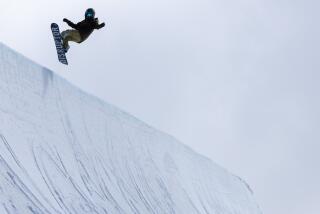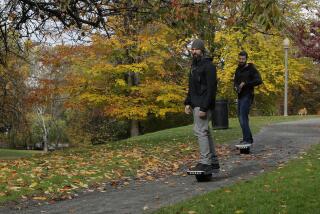A heady issue
- Share via
Several high-profile deaths on ski slopes in recent years -- including Sonny Bono and Michael Kennedy, son of Robert F. Kennedy -- have highlighted a tricky issue for the ski industry: the danger factor of bodies hurtling down slopes at high speeds. Combined with rising lawsuits from slope accidents and the popularity of snowboarding, they point up the need for ski helmets, a controversial issue in snow-user circles.
Most resorts quietly support helmets. No one wants to create an impression that skiing isn’t safe. But that discreet approach changed earlier this month when Consumer Reports announced that one of the top ski helmet producers, Boeri, didn’t make the safety grade on one of its models.
Now, skiing’s helmet safety issue is in the open. In its test, Consumer Reports chilled 13 helmet models to between 0 and 9 degrees and dropped them from varying heights onto steel anvils to re-create field conditions. The Giro Nine.9 and Giro Fuse were rated the highest, while a version of the popular Boeri Rage was deemed “not acceptable” after the shell shattered in impact tests.
Let the fireworks begin.
“All our helmets meet or exceed the standards set by other agencies,” said Boeri Sport USA Vice President Jeff Ravreby. “Chilling a helmet to 0 or 9 degrees and dropping it on an anvil never happens. Your body heat alone will warm the helmet significantly. This test is bogus.”
Consumer Reports stands by its results. “All the other helmets were tested to the same standard, and they didn’t have a similar reaction,” said John Galeotafiore, a director of testing at Consumer Reports.
Boeri produces about 40% of the helmets sold in the U.S. every year, said Ravreby. But now the company faces a quandary: How do you defuse a negative report without scaring customers away?
In many ways, it’s a problem the skiing and snowboarding industry has always had to face, the perception that the sports are dangerous. And while Timothy White of the National Ski Areas Assn., an industry trade group, concedes that snow sports’ rates of injury are higher than, say, those of hiking, he argues that “skiing and snowboarding have been unfairly depicted as deadly by the media.”
As companies attempt to sell more highly profitable safety equipment -- $67.3 million was spent on ski helmets last year, at an average of $83 apiece -- they walk a thin line. “We don’t want to send a message that this is such a dangerous sport that you have to wear a helmet,” says Ravreby. “We don’t want resorts to begin requiring protection.”
But mandates are beginning to pop up anyway. A 6-year-old girl died last year on a Colorado mountain after she crashed into a tree during a ski lesson. She was not wearing a helmet, and the parents sued. The resort, Aspen Highlands, now requires helmets on ski school students. Other resorts, frightened by the litigation, are posting pro-helmet signs.
The U.S. Consumer Products Safety Commission estimates that 40% of the 23,000 skiers and snowboarders who suffered head injuries last year could have lessened the severity of their injuries by wearing a helmet. But it’s no guarantee. Last month, a 13-year-old California girl, wearing a helmet, crashed into a tree while skiing at Alpine Meadows near Lake Tahoe and later died.
Some observers worry about an ironic side effect of more helmets: Studies have found that, as safety gear is more widely used and people feel more secure, they begin taking greater risks. Although bike helmets are now widely used, the incidence of bike injury has also risen.
For White of the ski group, the solution is to get people to “wear a helmet but ski or ride as if you didn’t have one on your head.”
More to Read
Inside the business of entertainment
The Wide Shot brings you news, analysis and insights on everything from streaming wars to production — and what it all means for the future.
You may occasionally receive promotional content from the Los Angeles Times.










